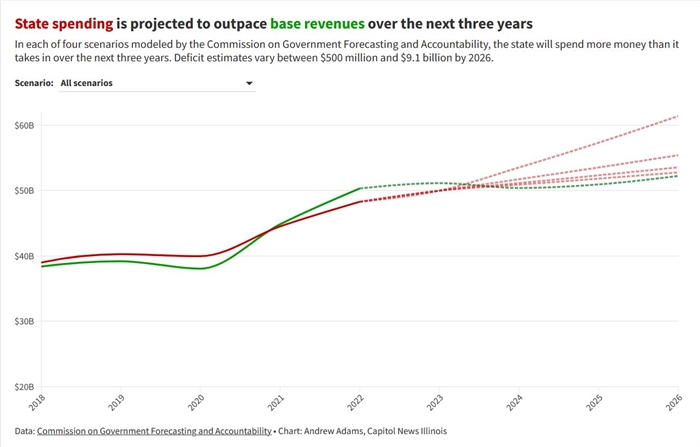Report suggests Illinois state spending will soon begin outpacing revenues once again

SPRINGFIELD – While Illinois has recently experienced a prolonged stretch of good financial news, a new state fiscal forecast notes that if spending continues to grow at its recent pace it could lead to future budget deficits.
It would mark the reversal of a recent trend during which the state logged considerable surpluses this fiscal year and the two years prior.
In the highest-spending scenario outlined in the three-year forecast from the Commission on Government Forecasting and Accountability, the state could once again face a bill backlog as high as $18 billion. That estimate assumes spending growth at its five-year average of 7.1 percent.
“This example shows that spending patterns seen in the past few years cannot continue without a comparable increase in revenues which is not seen in the commission’s current estimates,” the report from the legislature’s nonpartisan forecasting commission noted.
If the state keeps spending growth at 1.8 percent – the most austere scenario outlined by the commission – it could maintain an accounts payable balance of $1.4 billion, the same as it was at the end of Fiscal Year 2022.
Even in that scenario, state spending would outpace revenues in the upcoming Fiscal Year 2024 that begins July 1 – although Gov. JB Pritzker has proposed decreasing state spending in FY 24.
His $49.6 billion proposed spending plan for FY 24 represents a 0.7 percent decrease from the baseline number assumed in the COGFA forecast. Lawmakers, however, are still working on crafting a final budget before their May 19 adjournment.
“We have to pass a balanced budget…Illinois has had a past where, you know, for a few years anyway, that didn’t happen,” Pritzker said at a news conference last week. “… And I think the General Assembly has taken that very seriously.”
While the new report illustrated that lawmakers may have to tighten their belts in the coming years, it remained consistent with previous projections by the commission and other forecasters that have suggested an economic slowdown is on the horizon.
The COGFA report noted that over the past five years, state revenues have grown at a rate of 12 percent on average, compared to the 7.1 percent average expenditure growth.
Pandemic-era federal stimulus funds have mostly dried up, however, and their effect on the nation’s economy is beginning to wane. Many economic forecasts anticipate a mild recession is on its way.
The slowdown was evidenced in COGFA’s March revenue update that was published this week, showing that revenues declined $563 million from the same month last year. It marked the first year-over-year decline for any month this year, but COGFA noted the drop was expected after a record March 2022.
In other words, revenue growth rates of 18 percent and 12 percent that were seen in fiscal years 2021 and 2022 are not likely to be repeated anytime soon.
COGFA anticipates revenues will shrink by 1.4 percent to $50.4 billion in the upcoming FY 24 and remain under current-year levels until FY 2026, when they jump 2.5 percent to $52.2 billion.
As for spending, one important caveat is that the growth of the past two years been at least partially driven by measures that COGFA described as “fiscal discipline.” That includes debt retirement, increased pension payments and long-term savings.
It has also included temporary tax relief and other one-time expenditures that won’t carry over from one fiscal year to the next.
But spending across human services, education and other agencies has also grown.
“Current forecasts would allow for more of this kind of spending in the short-term,” COGFA wrote in the report. “However, longer-term, economic and tax revenue forecasts remain murky as the potential for a recession remains.”
The three-year report also analyzed threats to the state’s fiscal position, including the potential recession, a COVID-19 resurgence, population loss and pension debt among others.
Many of the threats, the report noted, “can be directly linked” to “a long-term trend of having expenditures being higher than revenues.” It also noted that “work still remains” for the state to achieve a “budgetary system that is more stable in the long-term.”
“An opportunity exists to improve the state’s financial situation by better aligning the revenues and expenditures of the state. This can be done by raising revenues, cutting spending, or some combination of both,” the report noted.
Illinois could also achieve stability by broadening its sales tax to include more services.
“The Illinois sales tax was originally developed in the 1930s when the economy was much more reliant on goods production,” the report noted. “By taxing services, the tax system would modernize to more accurately reflect the economy of 2023.”
The revenues resulting from a service tax could be used to offset a portion of the sales tax on goods and “allow for the overall tax rate to be lowered,” according to the report.
The state could also save money by reducing statutory interest payments on overdue bills and using current-year surpluses for “paying down debt, investing for future growth, reducing taxes, and/or returning money to taxpayers.”
But on the whole, the report noted, “After the budget stalemate that occurred from 2015-2017, the state’s financial position has been getting better each year.”
That two-year impasse between Republican Gov. Bruce Rauner and Democrats in the General Assembly drove the state’s bill backlog to nearly $17 billion and caused crippling cuts across state agencies.
The report’s final piece of advice: “The State needs to continue to show fiscal discipline and demonstrate that the results of the past few years are not an anomaly.”
Miss Clipping Out Stories to Save for Later?
Click the Purchase Story button below to order a print of this story. We will print it for you on matte photo paper to keep forever.

